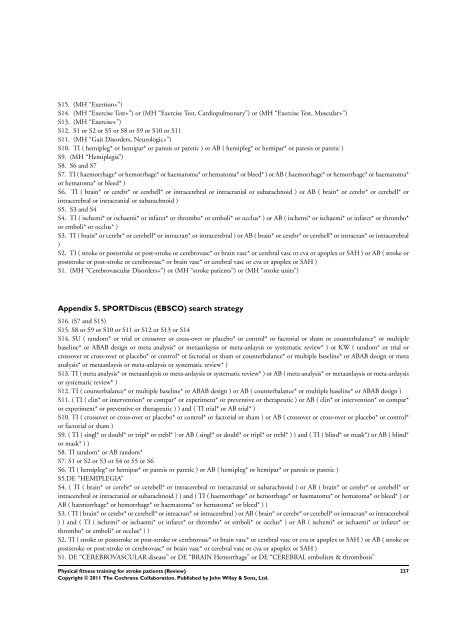Physical fitness training for stroke patients (Review) - Update Software
Physical fitness training for stroke patients (Review) - Update Software
Physical fitness training for stroke patients (Review) - Update Software
You also want an ePaper? Increase the reach of your titles
YUMPU automatically turns print PDFs into web optimized ePapers that Google loves.
S15. (MH “Exertion+”)<br />
S14. (MH “Exercise Test+”) or (MH “Exercise Test, Cardiopulmonary”) or (MH “Exercise Test, Muscular+”)<br />
S13. (MH “Exercise+”)<br />
S12. S1 or S2 or S5 or S8 or S9 or S10 or S11<br />
S11. (MH “Gait Disorders, Neurologic+”)<br />
S10. TI ( hemipleg* or hemipar* or paresis or paretic ) or AB ( hemipleg* or hemipar* or paresis or paretic )<br />
S9. (MH “Hemiplegia”)<br />
S8. S6 and S7<br />
S7. TI ( haemorrhage* or hemorrhage* or haematoma* or hematoma* or bleed* ) or AB ( haemorrhage* or hemorrhage* or haematoma*<br />
or hematoma* or bleed* )<br />
S6. TI ( brain* or cerebr* or cerebell* or intracerebral or intracranial or subarachnoid ) or AB ( brain* or cerebr* or cerebell* or<br />
intracerebral or intracranial or subarachnoid )<br />
S5. S3 and S4<br />
S4. TI ( ischemi* or ischaemi* or infarct* or thrombo* or emboli* or occlus* ) or AB ( ischemi* or ischaemi* or infarct* or thrombo*<br />
or emboli* or occlus* )<br />
S3. TI ( brain* or cerebr* or cerebell* or intracran* or intracerebral ) or AB ( brain* or cerebr* or cerebell* or intracran* or intracerebral<br />
)<br />
S2. TI ( <strong>stroke</strong> or post<strong>stroke</strong> or post-<strong>stroke</strong> or cerebrovasc* or brain vasc* or cerebral vasc or cva or apoplex or SAH ) or AB ( <strong>stroke</strong> or<br />
post<strong>stroke</strong> or post-<strong>stroke</strong> or cerebrovasc* or brain vasc* or cerebral vasc or cva or apoplex or SAH )<br />
S1. (MH “Cerebrovascular Disorders+”) or (MH “<strong>stroke</strong> <strong>patients</strong>”) or (MH “<strong>stroke</strong> units”)<br />
Appendix 5. SPORTDiscus (EBSCO) search strategy<br />
S16. (S7 and S15)<br />
S15. S8 or S9 or S10 or S11 or S12 or S13 or S14<br />
S14. SU ( random* or trial or crossover or cross-over or placebo* or control* or factorial or sham or counterbalance* or multiple<br />
baseline* or ABAB design or meta analysis* or metaanlaysis or meta-anlaysis or systematic review* ) or KW ( random* or trial or<br />
crossover or cross-over or placebo* or control* or factorial or sham or counterbalance* or multiple baseline* or ABAB design or meta<br />
analysis* or metaanlaysis or meta-anlaysis or systematic review* )<br />
S13. TI ( meta analysis* or metaanlaysis or meta-anlaysis or systematic review* ) or AB ( meta analysis* or metaanlaysis or meta-anlaysis<br />
or systematic review* )<br />
S12. TI ( counterbalance* or multiple baseline* or ABAB design ) or AB ( counterbalance* or multiple baseline* or ABAB design )<br />
S11. ( TI ( clin* or intervention* or compar* or experiment* or preventive or therapeutic ) or AB ( clin* or intervention* or compar*<br />
or experiment* or preventive or therapeutic ) ) and ( TI trial* or AB trial* )<br />
S10. TI ( crossover or cross-over or placebo* or control* or factorial or sham ) or AB ( crossover or cross-over or placebo* or control*<br />
or factorial or sham )<br />
S9. ( TI ( singl* or doubl* or tripl* or trebl* ) or AB ( singl* or doubl* or tripl* or trebl* ) ) and ( TI ( blind* or mask*) or AB ( blind*<br />
or mask* ) )<br />
S8. TI random* or AB random*<br />
S7. S1 or S2 or S3 or S4 or S5 or S6<br />
S6. TI ( hemipleg* or hemipar* or paresis or paretic ) or AB ( hemipleg* or hemipar* or paresis or paretic )<br />
S5.DE “HEMIPLEGIA”<br />
S4. ( TI ( brain* or cerebr* or cerebell* or intracerebral or intracranial or subarachnoid ) or AB ( brain* or cerebr* or cerebell* or<br />
intracerebral or intracranial or subarachnoid ) ) and ( TI ( haemorrhage* or hemorrhage* or haematoma* or hematoma* or bleed* ) or<br />
AB ( haemorrhage* or hemorrhage* or haematoma* or hematoma* or bleed* ) )<br />
S3. ( TI ( brain* or cerebr* or cerebell* or intracran* or intracerebral ) or AB ( brain* or cerebr* or cerebell* or intracran* or intracerebral<br />
) ) and ( TI ( ischemi* or ischaemi* or infarct* or thrombo* or emboli* or occlus* ) or AB ( ischemi* or ischaemi* or infarct* or<br />
thrombo* or emboli* or occlus* ) )<br />
S2. TI ( <strong>stroke</strong> or post<strong>stroke</strong> or post-<strong>stroke</strong> or cerebrovasc* or brain vasc* or cerebral vasc or cva or apoplex or SAH ) or AB ( <strong>stroke</strong> or<br />
post<strong>stroke</strong> or post-<strong>stroke</strong> or cerebrovasc* or brain vasc* or cerebral vasc or cva or apoplex or SAH )<br />
S1. DE “CEREBROVASCULAR disease” or DE “BRAIN Hemorrhage” or DE “CEREBRAL embolism & thrombosis”<br />
<strong>Physical</strong> <strong>fitness</strong> <strong>training</strong> <strong>for</strong> <strong>stroke</strong> <strong>patients</strong> (<strong>Review</strong>)<br />
Copyright © 2011 The Cochrane Collaboration. Published by John Wiley & Sons, Ltd.<br />
237












